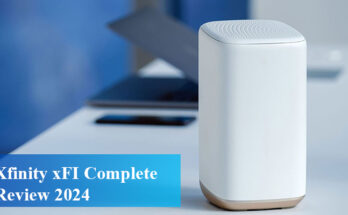If your best broadband internet at home keeps going off and you’re having problems, there could be various reasons behind it. Here, we’ve provided some solutions to help you get your internet connection back. Firstly, if you have multiple gadgets linked to the same internet, you can inspect how each one is connected. Often, the trouble might be with a particular device or its hardware rather than the actual connection. Try testing your internet separately on each device you have. If all devices on your network are experiencing the same issue, it suggests a problem with the cable, router, DSL modem, or your internet service provider (ISP). At Top Internet Plans, you can find the best broadband internet plans for comparison.
Cable or DSL Modem – If your DSL broadband cable modem is struggling to keep a stable connection and you’re constantly getting disconnected from the internet, try power cycling it. This could help if the modem is getting too hot and causing the problem.
Restart the Modem – To begin fixing a lost DSL broadband cable internet connection, start by turning off the cable modem. You can do this by unplugging the power cord from the back of the modem. Leave the modem unplugged for about a minute, then plug the power cable back in and turn it on. Give the modem a moment to perform some self-checks and re-establish the connection. You’ll notice a light on the front of the modem indicating the broadband connection. Once that light is lit up, you can plug in your router. After completing these steps, check to see if your internet connection issues have been resolved.
Network Issue from the Side of Your ISP – Your internet service provider (ISP) is a helpful place to turn if your computer keeps getting disconnected from the internet. The technical support team can perform checks on your system and the connection lines to find out if there are any problems between your computer and the broadband connection that might be causing these frequent disconnections. Don’t forget to ask them how to resolve our broadband internet in my area connection issues.
Virus or Malware Infection – A virus or malware on your computer could be the reason for your internet connection dropping often. If the infection is serious, it can lead to frequent disruptions in your broadband connection. To resolve these broadband connection issues, you’ll need to get rid of the virus or spyware from your computer. Make sure your virus protection is current to ensure a safe and beneficial broadband program connection.
Upgrade Your Modem – After multiple attempts at trying to fix your lost broadband connection, if you still face the same problem then you might want to look at getting a new modem or upgrading it to the latest version. Modems have in-built security cards which not only provide you with the home’s best broadband internet security, but; it also upgrades your broadband speed to a considerable degree. Updated modems can easily fix broadband connection problems.
Implement A WiFi Extender – If tinkering with your router’s configurations appears too daunting and you’re willing to spend a few dollars, consider investing in a Wi-Fi extender or repeater. These gadgets conveniently plug into available wall sockets, latch onto your router’s wireless signal, and amplify its reach.
Setting up these devices is generally straightforward, and their operation is user-friendly, instantly eliminating Wi-Fi dead spots within your home. Although the extended or repeated wireless signals may not match the intensity of those emitted directly from your router, their placement remains crucial. Utilize these devices primarily for connecting gadgets with lower bandwidth demands.
Usage of Electrical Wiring – Another option to consider instead of extenders is a powerline kit. Electrical wiring can carry digital signals, and powerline devices are specifically engineered to utilize this capability. Various manufacturers offer powerline networking kits, such as Netgear (available for $100 on Amazon) and TP-Link (priced at $50 on Amazon).
Here’s how it operates – Start by linking a powerline plug to your router and inserting it into a wall socket. Place an additional powerline plug in any other room of your residence, and it will establish a wired or wireless best broadband internet connection to that area. While there might be a slight reduction in speed, this approach is straightforward and efficient. Unless your dwelling is unusually aged, its electrical wiring should support this functionality. Nevertheless, it’s advisable to purchase your kit from a vendor with a dependable return policy as a precaution.
Remove Unused Devices – Dealing with numerous devices simultaneously utilizing Wi-Fi can pose challenges. Whenever possible, connect devices via Ethernet cables or DSL broadband cable and disconnect any unnecessary connections (such as that “smart” tea kettle that never quite worked). Ensure that only essential devices are connected to the internet.
Modern routers (including all the routers mentioned earlier) provide features to prioritize specific devices or services. This functionality is convenient for guaranteeing uninterrupted gaming sessions, even when others are streaming videos on platforms like Facebook.
Keep Your WiFi Password Protected – It’s likely unnecessary to emphasize, but having a password for your Wi-Fi network is essential. This measure effectively safeguards against potential hackers and prevents neighbors from utilizing your bandwidth for Netflix and causing a slowdown. When establishing security at broadband internet in my area, I always opt for AES encryption – the optimal choice for a balance between robust security and minimal impact on speed.
In conclusion, ensuring a seamless and high-speed broadband internet experience at home requires a combination of strategic solutions and prudent measures. Addressing issues such as device connectivity, modem stability, and network disruptions can significantly enhance your internet reliability. Exploring options like upgrading modems, employing Wi-Fi extenders, or utilizing powerline kits can mitigate dead zones and maintain consistent coverage across your residence. Prioritizing essential devices and maintaining a secure Wi-Fi network through password protection are key steps to guard against unwanted interruptions and potential security breaches. By adopting these strategies, you can bid farewell to lag and welcome a smoother online experience that meets your digital needs effectively and efficiently.



